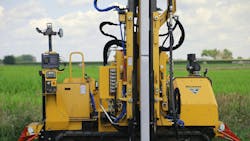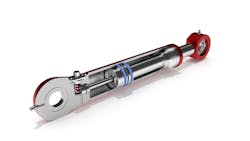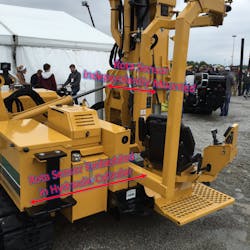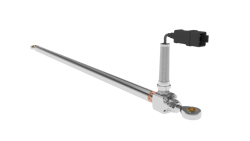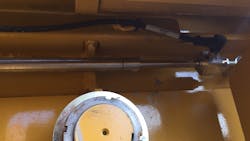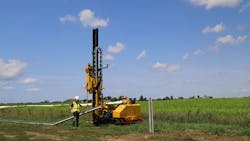Hydraulic Cylinder Sensors Aid Pile Driver Accuracy
Incorporation of sensors into hydraulic cylinders can help them move in a more precise manner, enabling improved accuracy and the ability to automate machine movements. These capabilities were demonstrated when Rota Limited worked with heavy equipment manufacturer Vermeer on the development of its PD10 pile driver for solar field installations.
A high level of accuracy is required when driving the piles used to support solar panels into the ground during a solar field installation. Understanding this, Vermeer contacted Rota about integrating its linear position sensors into two of the PD10's hydraulic cylinders. Adding the sensors would help to ensure accuracy when driving piles into the ground as well as help to automate this typically difficult and repetitive task.
Piles need to be driven into the ground 10 ft. apart, at just the right angle, thousands of times a day during a solar field installation. “[This is] a very repetitive process that really needs to be automated and [cohesive] so there is a nice, feng shui look of the solar panels when you’re done,” said Jake Hewes, PMP, International Sales Manager at Rota Limited.
With the Rota sensors, Vermeer was able to design the PD10 so operators could more easily install piles at the correct location, depth and angle to achieve the accuracy and aesthetics desired by the project at hand.
Hydraulic Cylinder Position Sensor Enables Precise Control
Rota’s linear position sensors are based on Hall Effect technology – an absolute technology which is robust and resistant to high-vibration applications, said Hewes, which benefits its use in the Vermeer PD10. The sensors provide x and y axis readings to help accurately align the pile driver.
Integrating the sensors enables electronic feedback to be added to the hydraulic cylinders for more precise control and adjustment of the stroke length. “Say it is a 12-in. stroke cylinder. Each time it moves a fraction of an inch, you get a reading on your electronics,” explained Hewes.
This feedback can be communicated to the machine’s CANbus and software to better calculate and adjust the pile driver to the desired angle.
The driving depth of the pile can be better controlled as well, mitigating the risk of over- or under-penetration to ensure the structural integrity of the solar panels. This helps to minimize any possible rework, improving productivity and efficiency of the solar field installation.
Two different types of Rota sensors were used in the PD10. The initial goal was to embed them in the machine’s hydraulic cylinders to protect the sensors from the shocks and vibrations that would likely be experienced in this application.
One of the sensors is embedded in a hydraulic cylinder used on the substructure of the pile driver. Hewes said keeping the pin-to-pin dimensions of a hydraulic cylinder unchanged can be difficult when embedding a sensor. “A lot of times the cylinder will need to grow in length to add a sensor,” he explained. “Because our technology is Hall Effect and fits in a small package, it allowed us to fit one of the sensors in the cylinder without increasing the pin-to-pin [dimensions] which was key to fitting it underneath this machine.”
The second sensor in the mast of the machine is an independent mount sensor. While Rota had a solution which could be embedded into a hydraulic cylinder, its location made it difficult to run necessary wire harnesses or connectors without them getting damaged. “The solution was to remove the sensor from the cylinder and bolt it in parallel with the cylinder a safe distance away from it where we could run the wire harness safely through the machine to prevent it from being damaged in the field,” explained Hewes.
For this sensor, Rota used a heavy-duty stainless-steel version to ensure it could withstand the high-vibration environments in which the pile driver would be working.
To ensure optimal integration of the Rota sensors, the company worked closely together with Vermeer and its hydraulic cylinder supplier. Multiple groups at Vermeer needed to be involved, including its electronics department to specify the CANbus signal. “It really becomes a three-way conversation” between Rota, Vermeer and the cylinder manufacturer said Hewes.
READ MORE: Sensors and Software Bring Performance Benefits to Motion Control Systems
Electronics Improve Pile Driver Accuracy and Ease of Use
Integration of the Rota sensors and other electronics as well as software on the PD10 enabled better drilling accuracy and ease of use to be achieved, key goals for Vermeer when it was developing the pile driver for use in solar field installations.
Without the sensors or other electronics, ensuring the pile is driven at the correct angle and depth would be a more visual, hands-on type of job which could lead to errors. Hewes said that if machine operators can see the hydraulic cylinders, it may be easier for them to ensure accurate drilling.
However, he said as soon as the cylinders are no longer visible – as is the case with the Vermeer pile driver – because they are tucked into a machine or behind the operator “it becomes extremely advantageous to have a position sensor inside of [the cylinder] so that you can see [the drilling angle] on your dash.”
The PD10 features an integrated control system, providing operators with a range of machine information such as pile angle, height as well as maintenance needs, much of which is possible because of the inclusion of the position sensors in the hydraulic cylinders said Hewes. Providing operators with easy access to this information helps them to stay on task and ensure they are installing the piles as desired by the project at hand.
The linear position feedback provided by the Rota sensors also enables real-time monitoring and analysis of the machine’s driving force and impact. Immediate adjustments can be made to these when necessary because of the electronic control capabilities provided by the sensors, helping to prevent potential damage to piles or the machine itself.
READ MORE: Sorting Out Linear Actuators
Electronic feedback provided by the sensors can be used for pre-calculated automation or angle figures as well. “If you want to drive the piles at a 20-degree angle…that can be calculated in the machine’s control system,” he said.
With this capability, automated functions can be added to a machine as Vermeer did with the PD10. An auto plumb feature on the pile driver automatically moves the mast to a plumb orientation with a simple push of a button which Vermeer says can reduce cycle time – aiding overall productivity and efficiency of an installation. This also makes the task easier for operators, an increasingly important aspect with construction equipment of all types due to the lack of skilled labor entering the industry.
Making the machines easier to use helps get novice operators up to speed faster while also helping even the most experienced operators do the job correctly the first time which is critical to ensuring projects are completed in a timely manner.
Hewes said customers he’s spoken to have found the Vermeer PD10 pile driver to be extremely precise, to the point where they can create solar fields with an aesthetically pleasing flow – making them more attractive to the communities in which they are installed and potentially helping further the market uptake of solar fields to meet increasing sustainability initiatives.
Growing Use of Sensors and Automation in Off-Highway Machinery
Jake Hewes, PMP, International Sales Manager at Rota Limited, said the company is definitely seeing a massive uptick in the use of sensors within hydraulic systems. As such, the company is continuing to add more personnel to help work with the growing number of OEM and hydraulic cylinder manufacturer customers using its sensors.
Use of hydraulic cylinder sensors continues to gain ground in mobile agricultural equipment, in particular. Hewes said it is a different driving force in this market because you are selling to farmers who are willing and ready to pay for added features, like automation, that will save them time.
On the construction equipment side, the machines are typically sold to a rental company. The addition of sensors and automation is not so much for time savings and benefits but to start overcoming the skills gap facing the construction industry he said.
“You may have a senior operator on an excavator that has hours and hours of [experience]. There's a decent learning curve to operating an excavator,” said Hewes. But as you make it more automated, it can become easier through use of joystick controls similar to a video game. “That has a much shorter learning curve and has a lot of built-in safety aspects to it.”
He said this greater demand for sensors and automation is just starting to see it take off in the construction sector. The agricultural equipment market is by no means mature, but it has been ahead of the construction industry in regards to uptake of these technologies.
Hewes noted Vermeer actually offers two versions of the PD10 pile driver; the PD10R model has no operator cab but instead enables wireless remote control of the machine. All other aspects, including use of the Rota sensors, are the same as the original PD10 pile driver but with the ability to remotely operate the machine as a means of further improving ease of use and solar field installation efficiency.
About the Author
Sara Jensen
Executive Editor, Power & Motion
Sara Jensen is executive editor of Power & Motion, directing expanded coverage into the modern fluid power space, as well as mechatronic and smart technologies. She has over 15 years of publishing experience. Prior to Power & Motion she spent 11 years with a trade publication for engineers of heavy-duty equipment, the last 3 of which were as the editor and brand lead. Over the course of her time in the B2B industry, Sara has gained an extensive knowledge of various heavy-duty equipment industries — including construction, agriculture, mining and on-road trucks —along with the systems and market trends which impact them such as fluid power and electronic motion control technologies.
You can follow Sara and Power & Motion via the following social media handles:
X (formerly Twitter): @TechnlgyEditor and @PowerMotionTech
LinkedIn: @SaraJensen and @Power&Motion
Facebook: @PowerMotionTech
